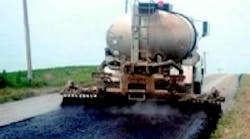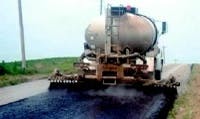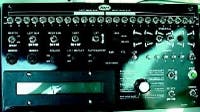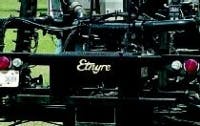Ask someone from a northern state or Canada about the seasons of the year, and you'll likely hear, "We have two: winter and road construction season." This implies that road construction equipment must be designed to operate in hot environments. Plus, the high temperatures generated from heated asphalt creates conditions that can wreak havoc on electronic controls.
To tolerate the high temperatures and other hostile conditions of asphalt distributors, E.D. Etnyre & Co., Oregon, Ill., developed their Black Topper asphalt distributor. The Black Topper uses controlled area network (CAN) components that not only stand up to high temperatures, but enhance operation as well.
Etnyre has come a long way in the last 100 years, when their bituminous distributors were powered by horses and controlled by hand. More recently, engine-driven vehicles have allowed some extent of automation, but operators must be skilled at steering the distributor while controlling the rate of asphalt application. Furthermore, drivers usually become fatigued toward the end of a work day, which leads to less consistent application.
Today, Etnyre's machines rely on microprocessor control to cover roads with a greater consistency and efficiency. Much of this success stems from the combined expertise of Etnyre engineers and Hydro Electronic Devices (HED) Inc., Hartford, Wis., which specializes in developing control systems for mobile equipment.
Compared to alternative solutions, the modular units comprising the Black Topper's CAN system enable higher current outputs, more rugged construction, and lower cost, while taking up less space on the machine. The CAN system helps the distributor spray just the right amount of asphalt to match road surface topography and conform to the lane width.
From the cab of the Etnyre Black-Topper asphalt distributor, the operator has full control over all spraying functions while driving the vehicle along the road. The electronic control system guarantees that the correct amount of asphalt is dispensed according to vehicle speed and road conditions. Material passing through the hydrostatic pump goes directly through the spray nozzles. This offers better control than conventional systems, which instead use a bypass valve. The system provides full pressure balanced, dual-feed asphalt while spraying to ensure uniform application across the full length of the spray bar — up to 24 ft, so two full lanes can be covered at once.
In and on the vehicle
On board, the operator manages and monitors asphalt spraying from the user interface panel developed by Etnyre, controlling application rate in 1-ft increments. The system assists the operator by providing up to 10 preset application rates that are selected by the push of a button. Each application rate remains consistent regardless of changes in vehicle speed or spray width. This is done by matching pump output to distributor speed. Accurate ground speed and distance is fed to the system through a radar-sensing device, which has no moving parts, so maintenance and potential for damage are almost non-existent.
Under the truck, two Etnyre large cross-section spray bars apply any of a variety of asphalts to the road surface. Asphalt flows to the spreader bar from a tank, heated by either LP gas or fuel oil. The operator selects the temperature — ranging from 150° to 400° F — based on the specific asphalt formula and application conditions.
In addition, the operator can specify the width of the spray to the computer. The bar responds to computer command through the CAN system and moves along two planes, in and out. This action changes the spray width automatically by sliding the spray bars past one another to vary the width of the spray. When the bars overlap, the computer signals the CAN system to turn the appropriate valves off.
The operator can keep an eye on the computer screen to check at the same time the application rate, flow, and distance traveled. The control automatically adjusts performance rates of the Black-Topper's 400-gpm pump for loading and circulating without changing the desired application rates. A hydraulic motor driving through a planetary gearbox enables the handling of rubber modified asphalts, and reduces problems otherwise associated with cold starts. Meanwhile, a built-in self-diagnostic program monitors all control circuits.
Enhancements from CAN
The HED system represents an upgrade from the components Etnyre used on previous versions of the Black-Topper spreader. To make this control possible, the computer communicates with modules controlling bar position and valve operation along the closed-loop CAN system over a common twisted pair of wires. This approach simplifies connections and offers design options within the confined space of the vehicle body to enhance production.
For this type of vehicle, CAN communication provides a very robust signal to withstand high electromagnetic and radio frequency interference from the abundance of electrical devices at a typical job site — power lines, radio transmitters, electric motors, solenoids, and other computers.
As part of the control system, the recently introduced CL-401 I/O module from HED provides higher current through 16 outputs for a wider range of electrohydraulic components, including the valves.
HED software engineers also programmed the system to provide more accurate pump control for less pulsing of the spray, fewer required setup parameters, and a user-friendlier setup screen in the cab. They also held down costs by specifying two CL-401 valve driver modules under the control of a second I/O module on a CAN bus system as an alternative to three slave modules required in other configurations.
With the heated asphalt coursing through the vehicle, the CAN components can withstand temperatures-from the job sites where the Black-Topper distributor is working typically during the hot summer months. In addition, the modules along the communication system are waterproof and withstand any direct contact with the asphalt.
By making application calculations and controlling sprayer system-functions, the Black-Topper's electronic controls boost consistency and efficiency to this final stage of road construction without requiring a more skilled driver.





